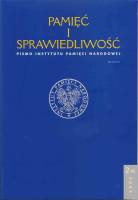Wysiedlenia Niemców z Polski po II wojnie światowej
Displacements of Germans from Poland after WW II
Author(s): Stanisław Jankowiak Subject(s): History
Published by: Instytut Pamięci Narodowej
Keywords: the future of German residents living in the borderland; the horro of Nazi occupation; the idea of displacement of all the Germans beyond new borders of Poland; the Potsdam conference; Federal Republic of Germany
Summary/Abstract: Experiences of the past, especially the horror of Nazi occupation, led to the opinion popular both among the Underground activists and the emigration politicians that Poland has to protect itself against another German aggression by moving the western border towards the Oder river. Such an attitude was often presented by the Polish government in the exile. It was also suggested that territories behind the Oder river should be occupied by the Poles. Similar opinions were held by the Communists, although their declarations concerning the borders were at first rather general.[...] Such a large change of the western border must have raised a question of the future of German residents living in the borderland. The failure of international authorities to protect the rights of national minorities during the interwar period and the tragic experience of WW II caused hatred towards the Nazis to expand onto all German people. No-one could imagine living in one country with the Germans. Thus the idea of displacement of all the Germans beyond new borders of Poland was commonly accepted.[...] An exile of such a large number of the Germans (about 3.5 mln) was not possible in such a way and in such a short time. However, at that time both Soviet and Polish postulates concerning borders were supported by representatives of Western superpowers. On the Potsdam conference a decision was taken to displace all the Germans from areas on the eastern bank of the Oder and Nysa Luzycka rivers. The displacement started in the beginning of 1946 and it was led in an organized way in the following years. Nevertheless, it did not mean that it was really planned to displace everybody. Not only war criminals or prisoners, but also so called professionals were tried to be kept in Poland. It should be underlined that „professionals” often meant anyone able to work. The situation of the Germans in Poland began to change at the end of the forties. It was decided then that all the Germans had left Poland, although the official end of the displacement did not mean the end of the process itself. Motions of individuals to leave were voted down. For political reasons it was only possible to leave to the German Democratic Republic. The situation changed during the Thaw in the middle of the fifties. Agreements with the Red Cross of the Federal Republic of Germany were signed then, which began the series of departures to West Germany. In the second half of the fifties the vast majority of the Germans in Poland desired to leave for the Federal Republic of Germany. In the beginning of the sixties it was officially acknowledged that there are no Germans in Poland, consequently the number of departures was much lower, transforming gradually into emigration, for which German origin was only one of the reasons.
Journal: Pamięć i Sprawiedliwość.
- Issue Year: 6/2004
- Issue No: 2
- Page Range: 139-160
- Page Count: 22
- Language: Polish

